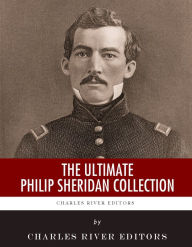The Ultimate Philip Sheridan Collection Charles
by River Editors
2020-04-22 04:02:59
The Ultimate Philip Sheridan Collection Charles
by River Editors
2020-04-22 04:02:59
Includes:•Charles River Editors’ original biography of Philip Sheridan•Personal Memoirs of P. H. Sheridan, General, United States Army by Philip Sheridan•Charles Johnston’s Philip Sheridan: The Daredevil•Sher...
Read more
Includes:•Charles River Editors’ original biography of Philip Sheridan•Personal Memoirs of P. H. Sheridan, General, United States Army by Philip Sheridan•Charles Johnston’s Philip Sheridan: The Daredevil•Sheridan’s Account of the Chattanooga CampaignA brown, chunky little chap, with a long body, short legs, not enough neck to hang him, and such long arms that if his ankles itch he can scratch them without stooping. – Abraham Lincoln describing Phil Sheridan “Little Phil” Sheridan was one of the smallest and toughest fighters in the Union Army, whose capabilities as both a general of infantry and cavalry made him one of the most valuable and versatile officers in the North. A close associate of Grant’s in the West, the 5’5 Sheridan was so critical that Grant brought him east in 1864 and gave him command of the Union cavalry to face off against the vaunted JEB Stuart. Despite his successes in the West and during the Overland Campaign, Sheridan’s most famous campaign was in the Shenandoah Valley, which had seen much fighting and Stonewall Jackson’s famous 1862 Valley Campaign. In 1864, however, Sheridan and his Army of the Shenandoah defeated Jubal Early and systematically destroyed the economic infrastructure and viability of the Valley, which had been considered the “breadbasket” of Virginia during the war’s earlier years. Residents of the Valley simply referred to Sheridan’s campaign as “The Burning”.After Sheridan’s cavalry proved instrumental in surrounding Lee’s army and forcing its surrender at Appomattox, Sheridan had cemented his legacy as one of the greatest Union generals of the Civil War. But he was far from done. During Reconstruction, he was a military governor responsible for trying to pacify Southern civilians in the wake of the Civil War, and it should come as no surprise that Sheridan and Southerners didn’t see eye to eye. Sheridan himself famously stated, If I owned Texas and Hell, I would rent Texas and live in Hell. Sheridan also ran afoul of President Andrew Johnson, who later removed him from his post. The tough and acerbic Sheridan was also one of the highest ranked officers who fought the Indian Wars in the decades after the Civil War. Notorious for uttering “The only good Indians I ever saw were dead, which has since been misattributed into more generalized and bigoted forms, Sheridan’s biographers have taken pains to try to point out that Little Phil wasn’t a racist, though there can be no denying he ruthlessly waged war on the Great Plains to subdue Native American tribes. Enemies on the battlefield rarely got the best of Sheridan, but his hard living finally caught up with him around the end of the 1880s, when Sheridan, in his 50s, began suffering massive heartattacks. By the time he died in 1888, he had been General-in-Chief and Commanding General of the U.S. Army, the very upper echelons of the military, and he was celebrated as one of the Civil War’s foremost heroes. The Ultimate Philip Sheridan Collection looks at the life and career of the scrappy Union hero, including an original biography of the life and legacy of Sheridan, his personal memoirs, his Official Records report of the Chattanooga campaign, and a short essay about his life. The Ultimate Philip Sheridan Collection also includes a Table of Contents and pictures of important people, places, and events in his life.
Less



























.jpg)
.jpg)

